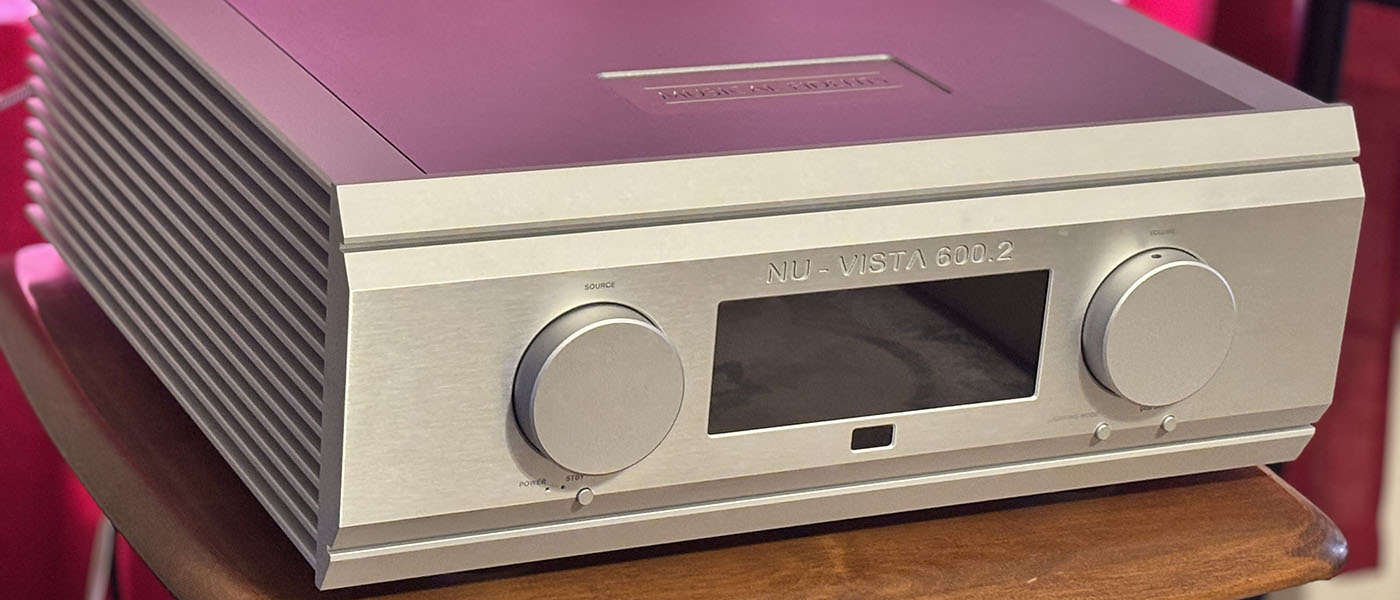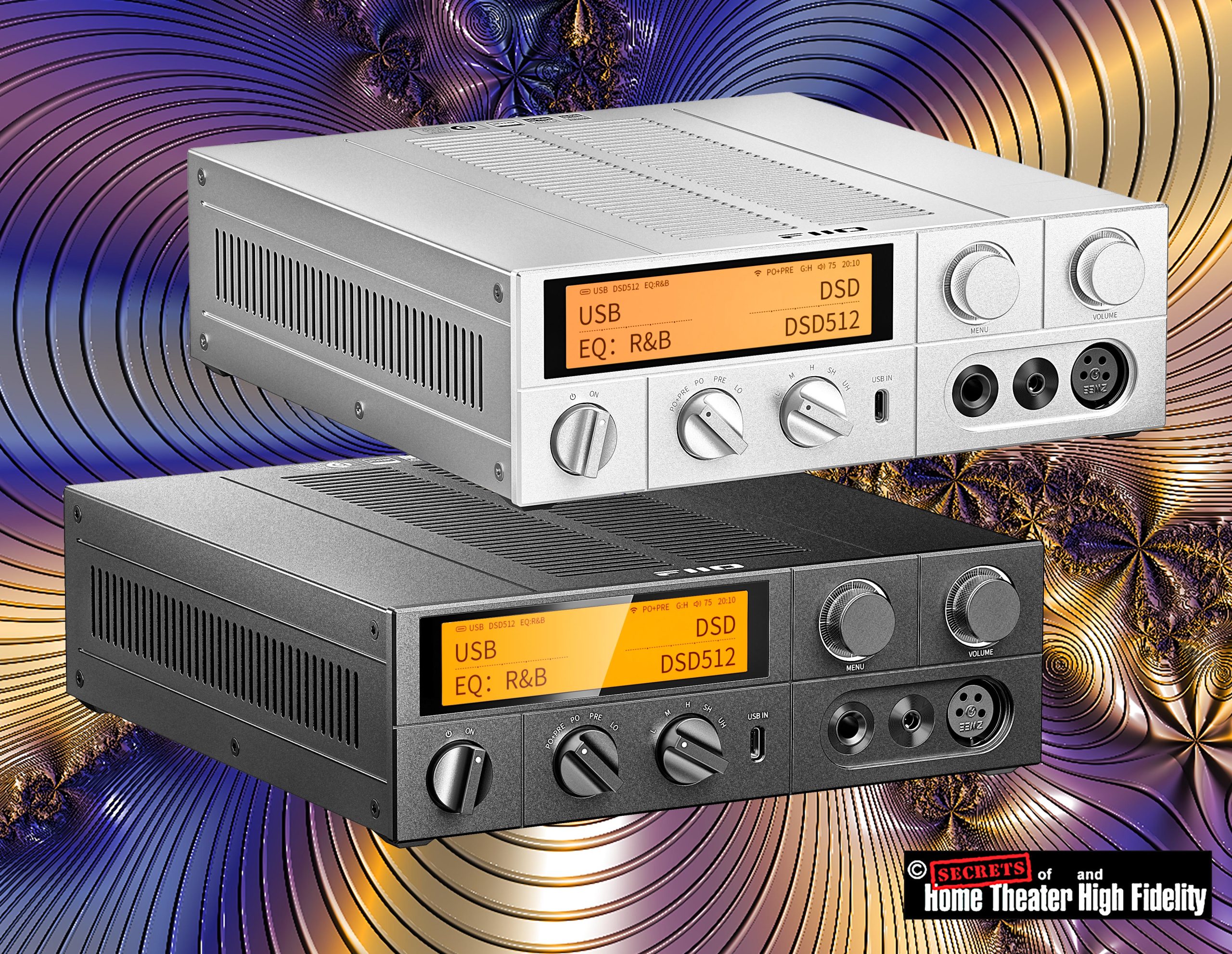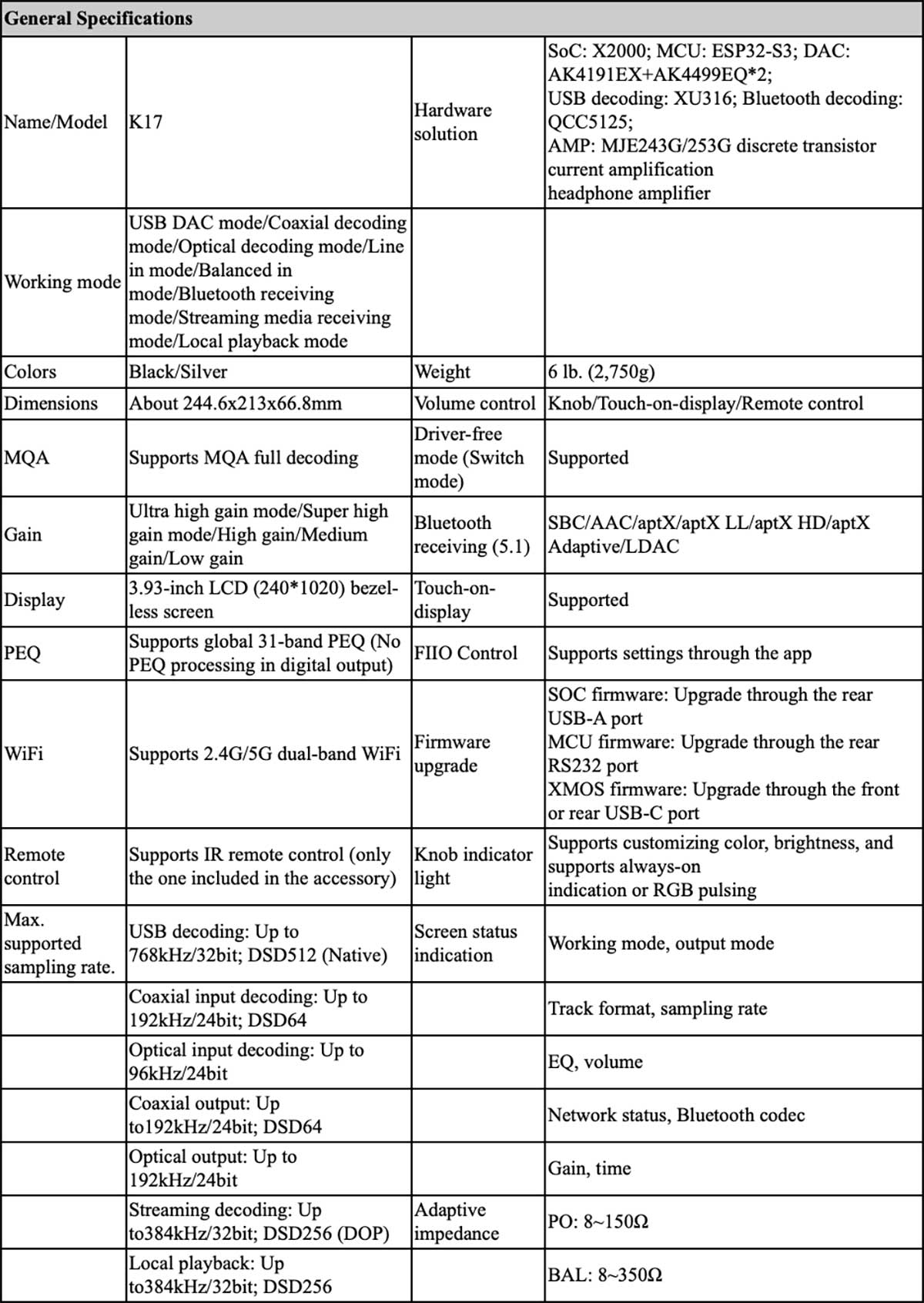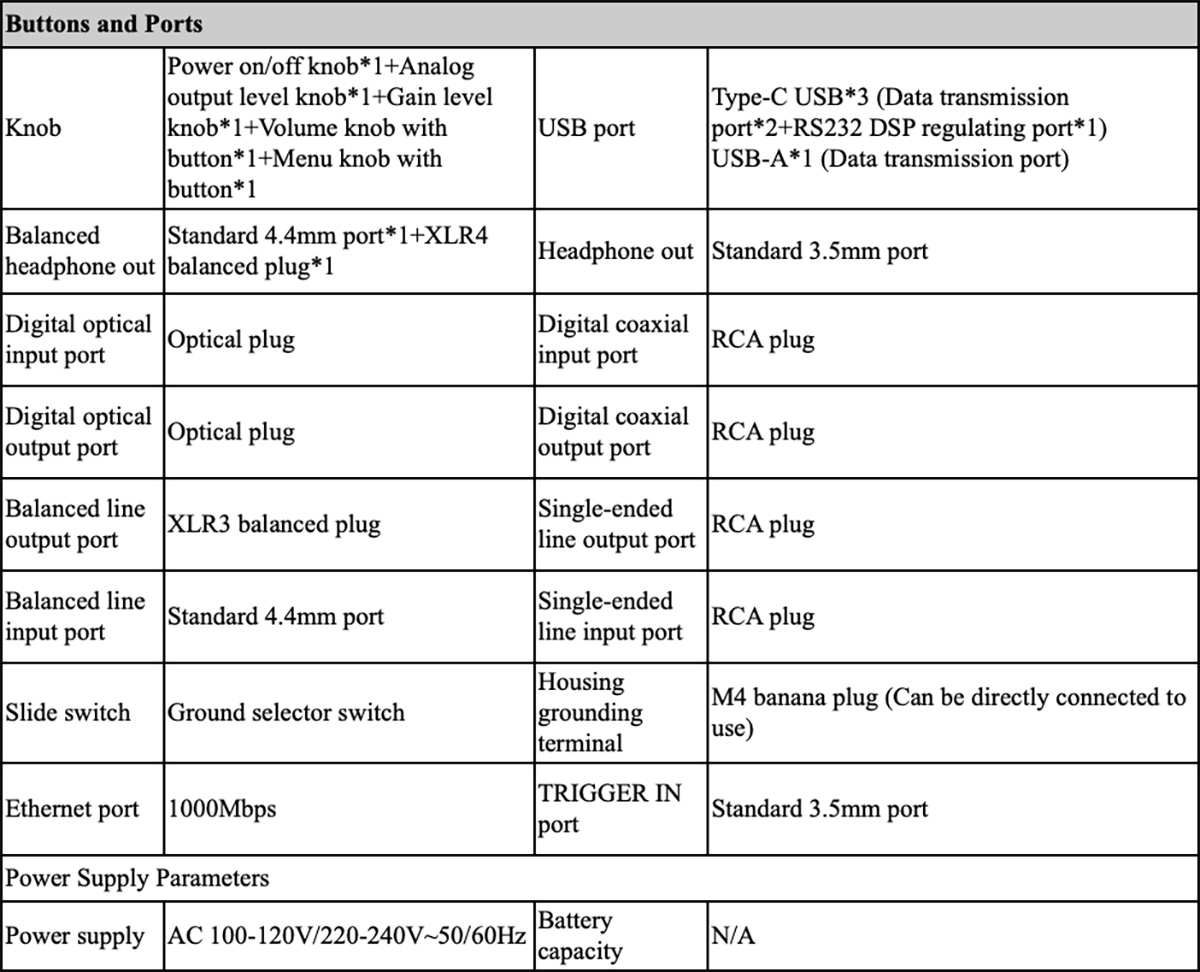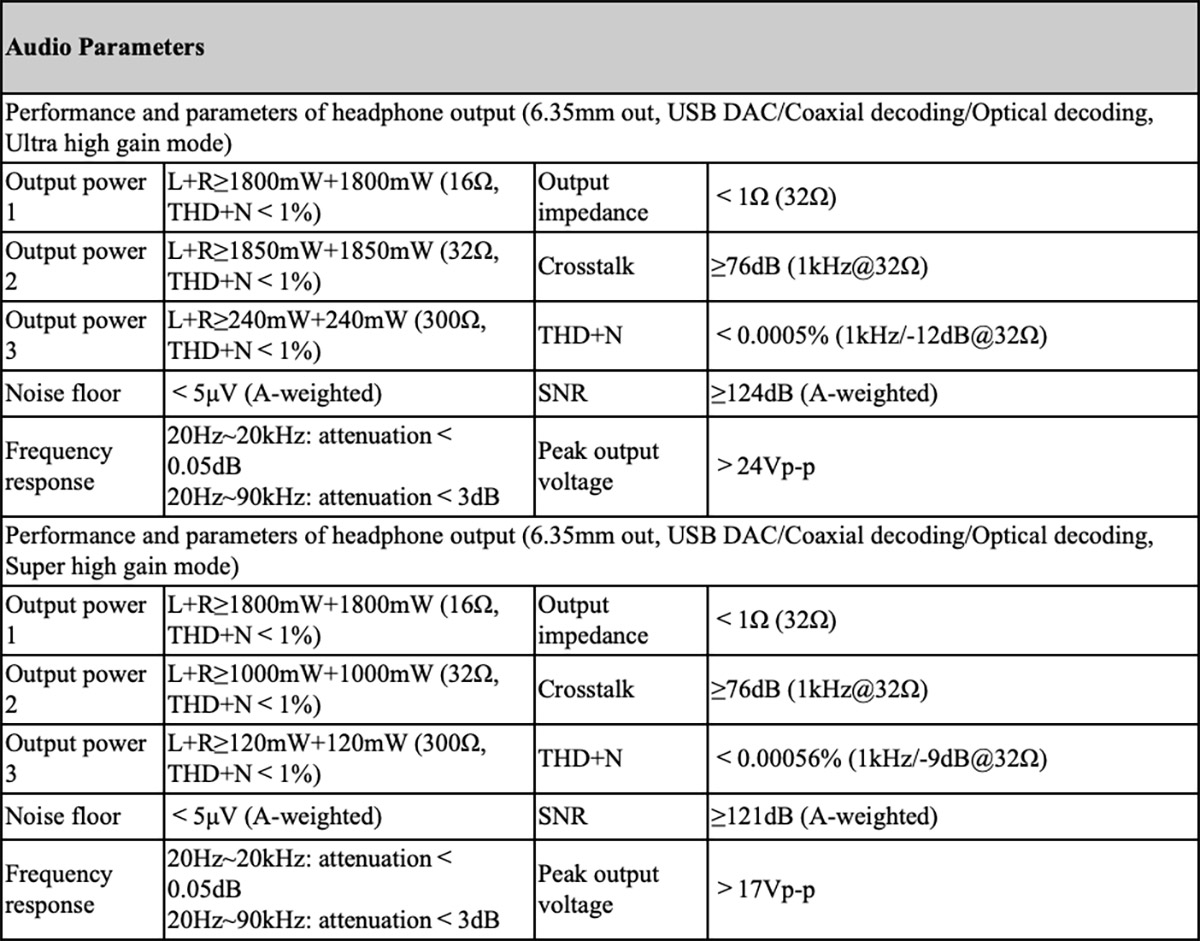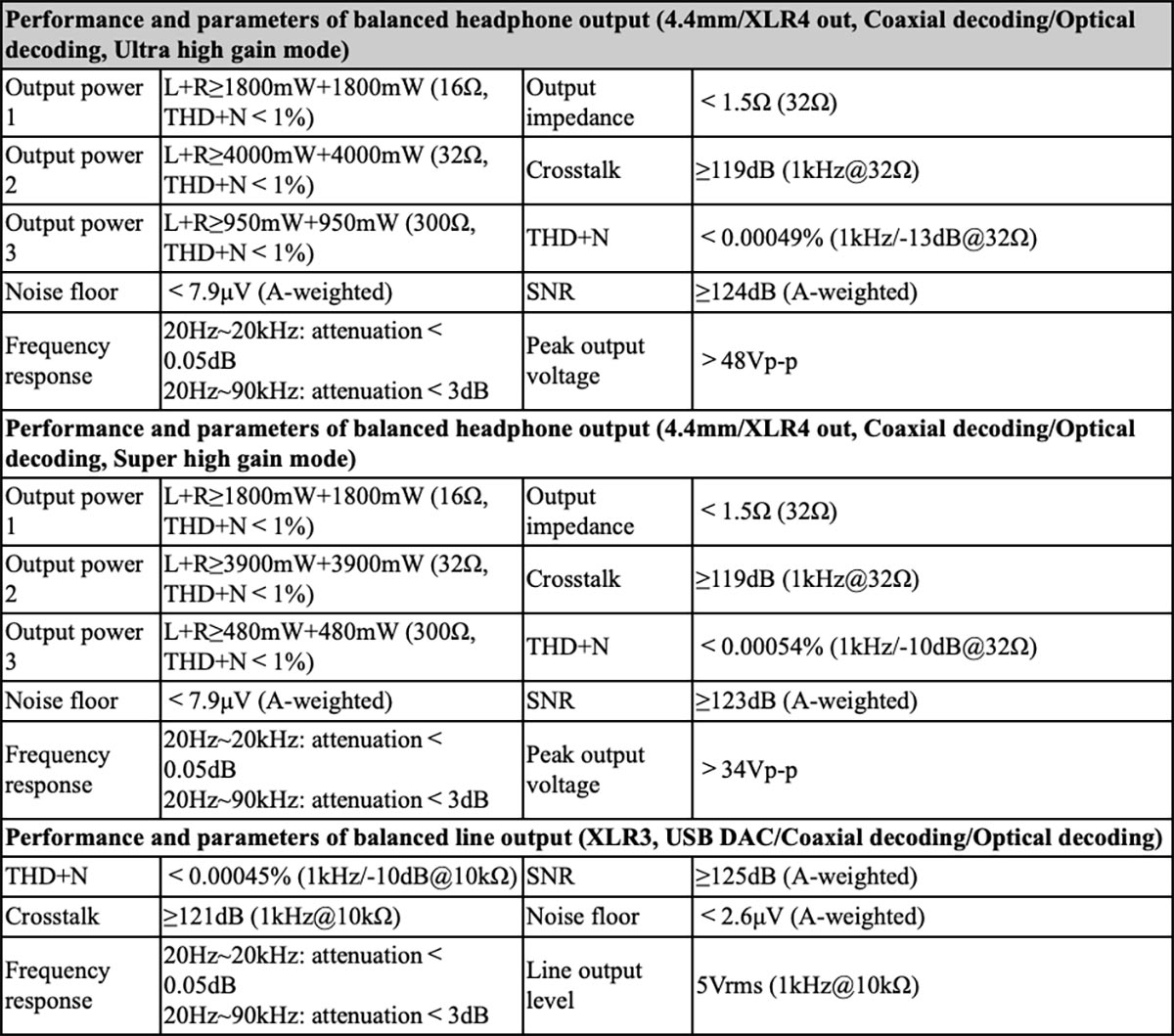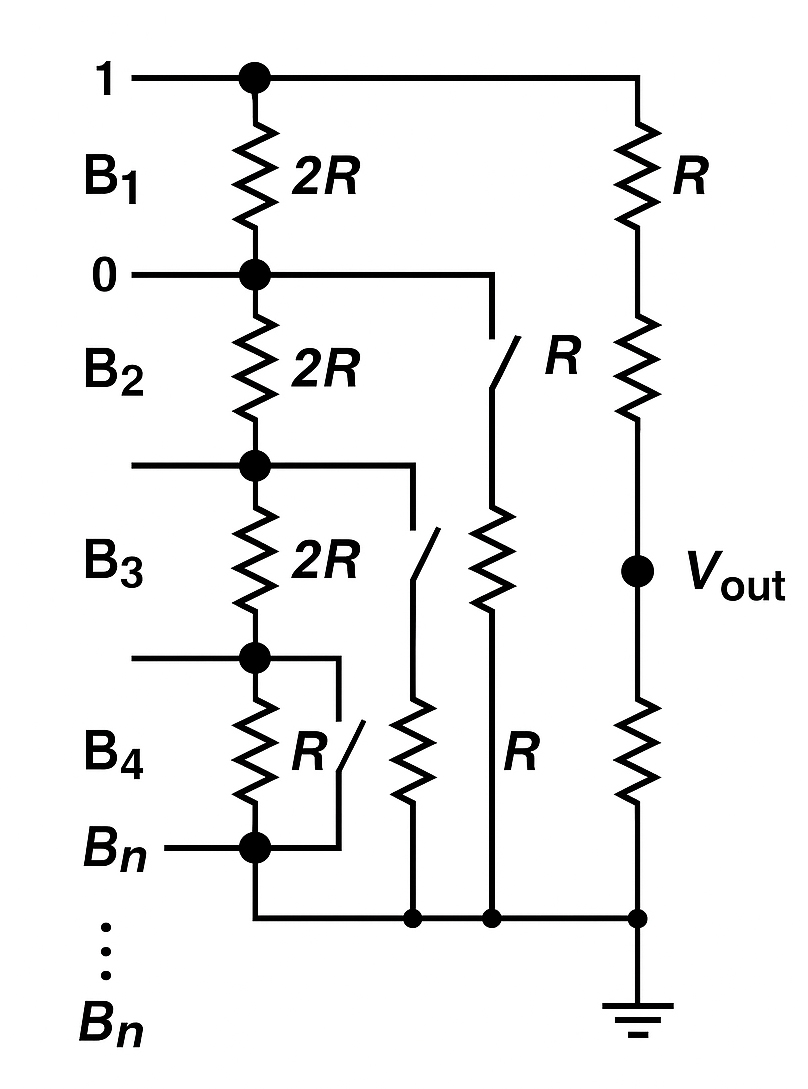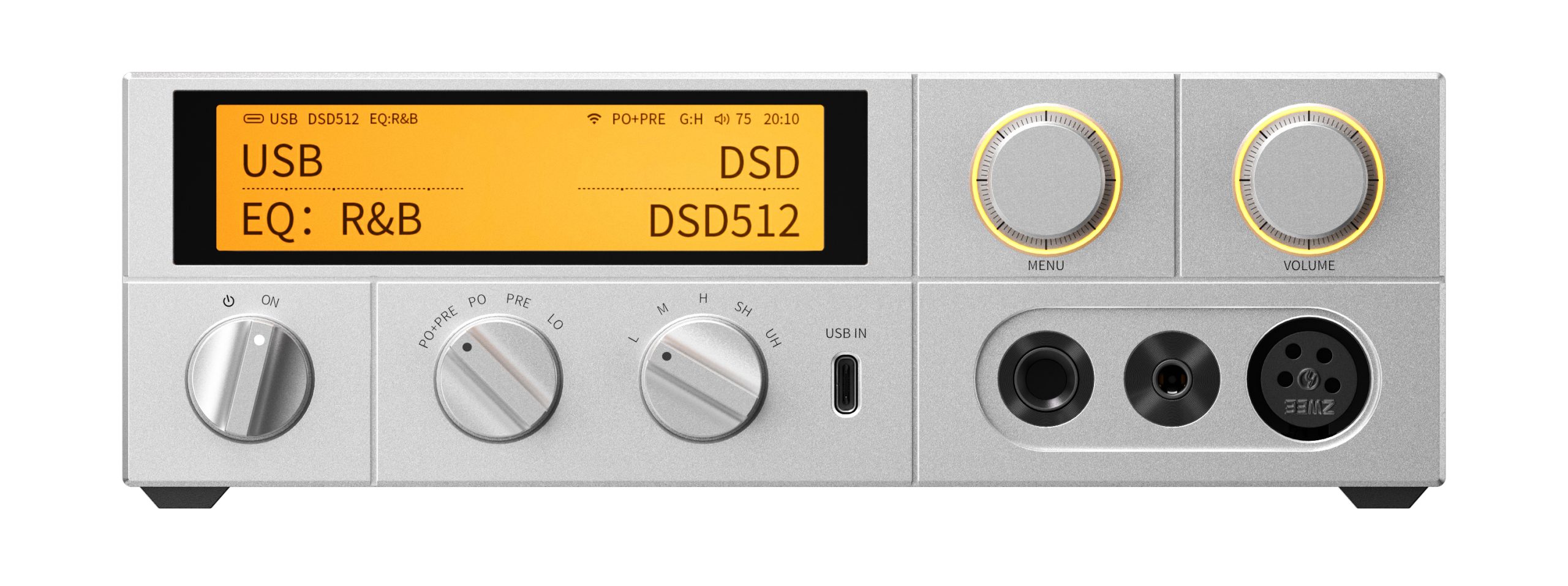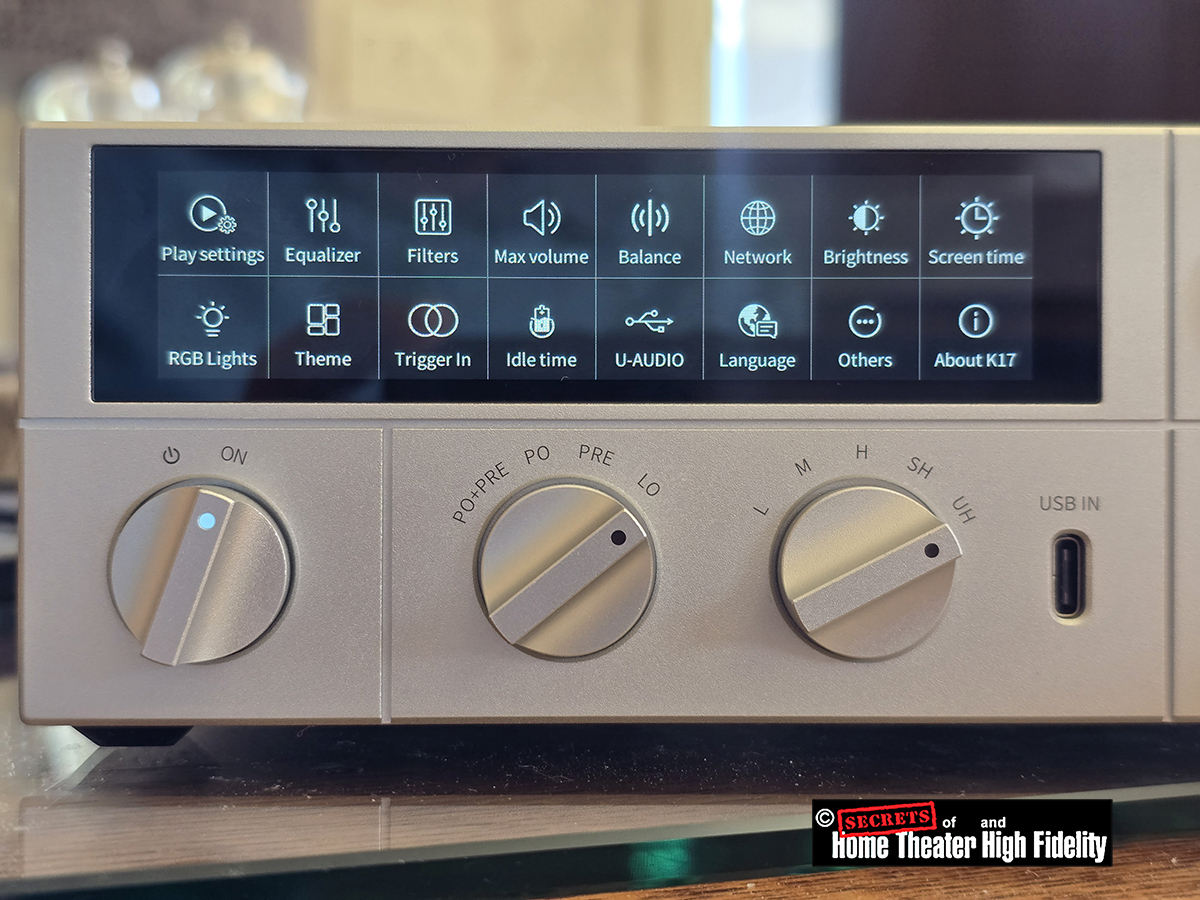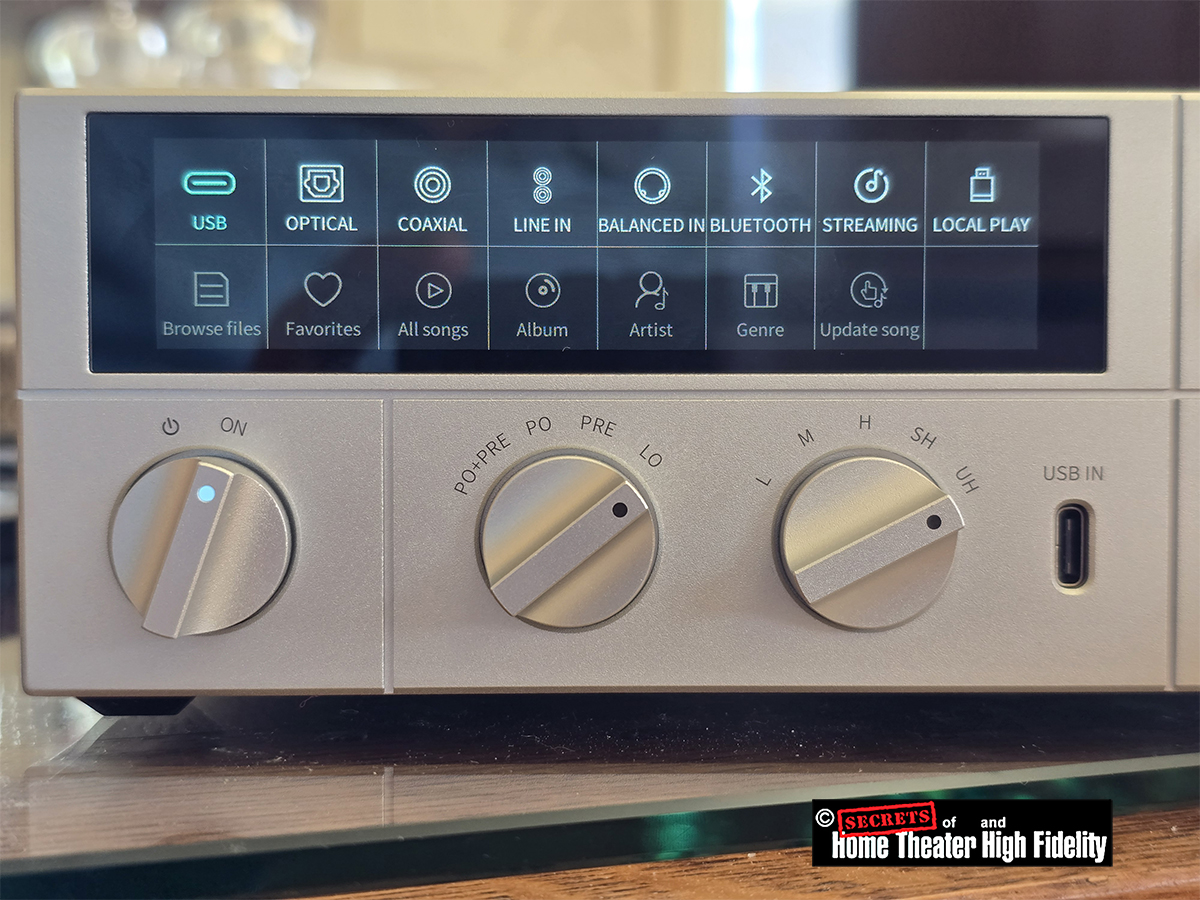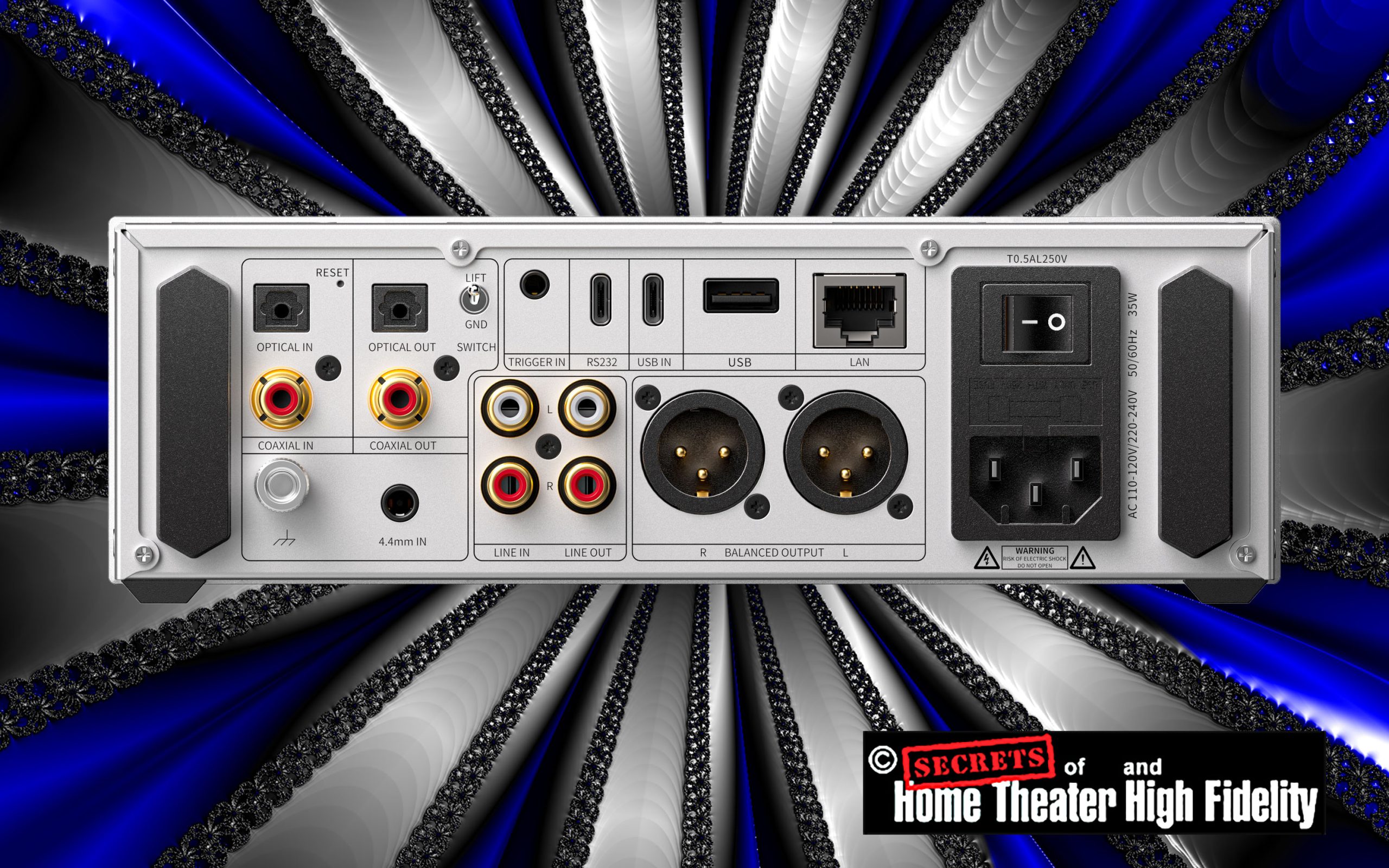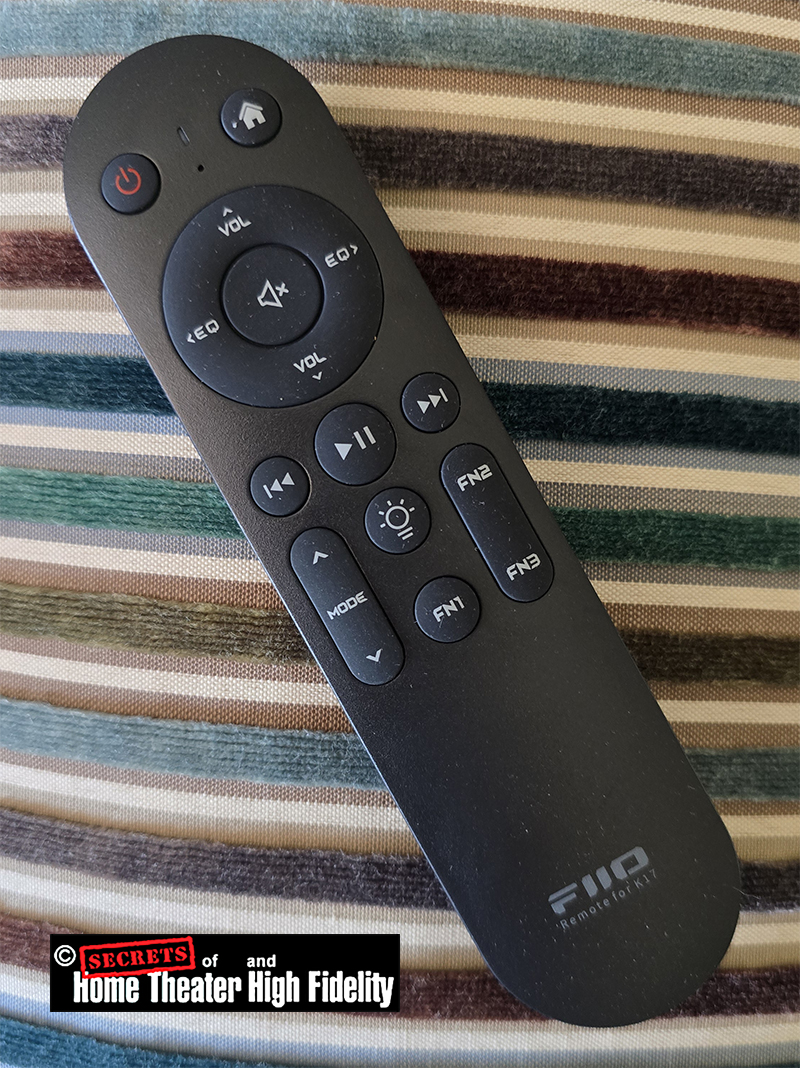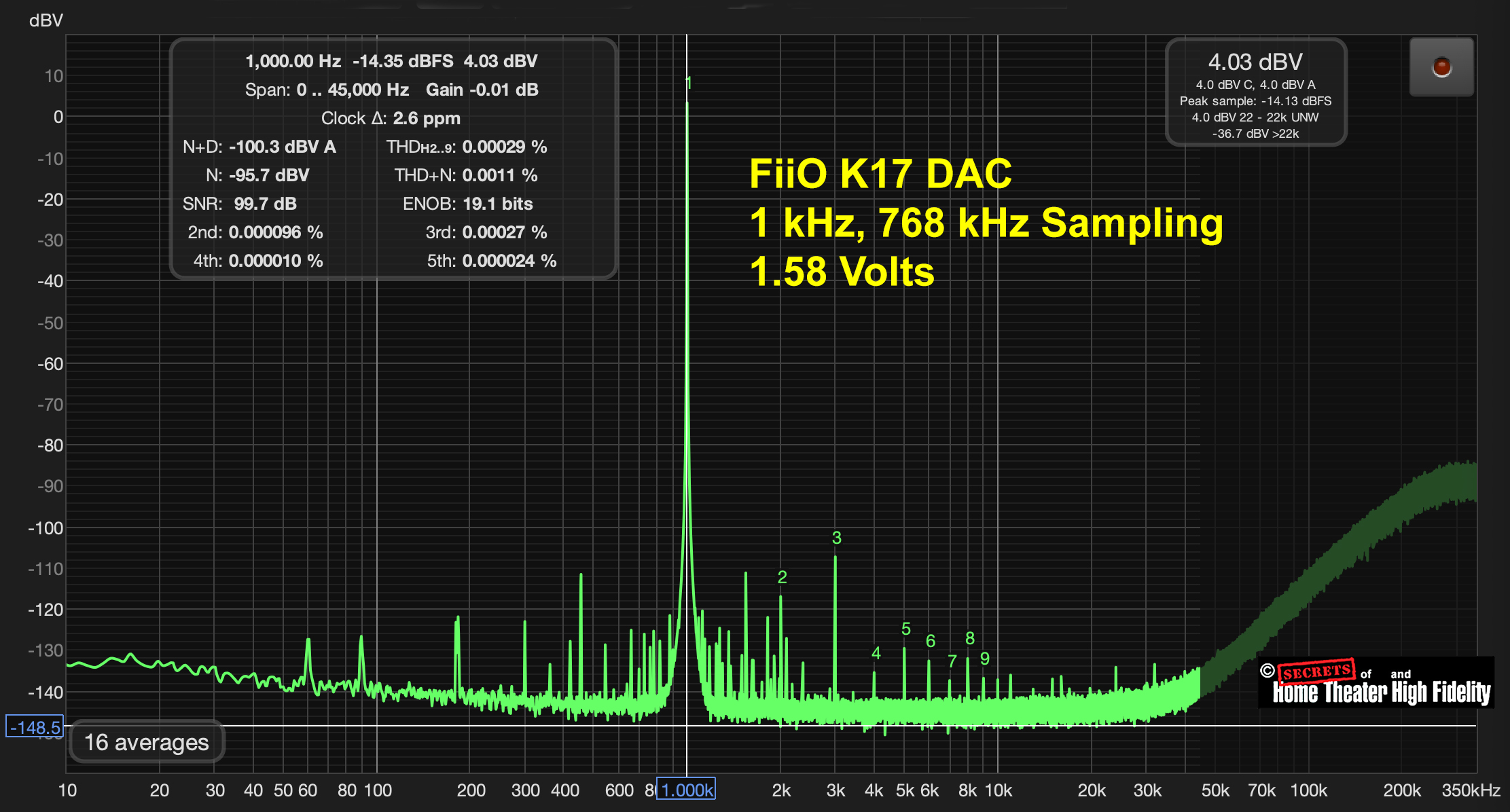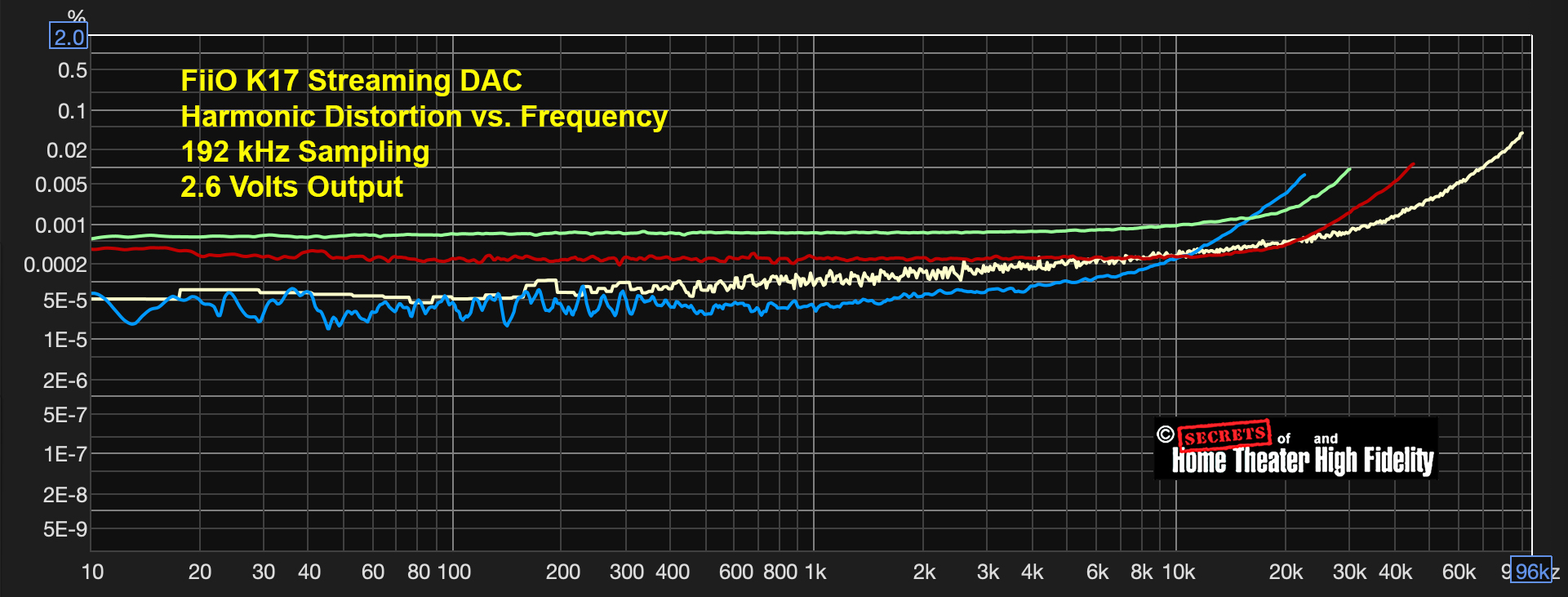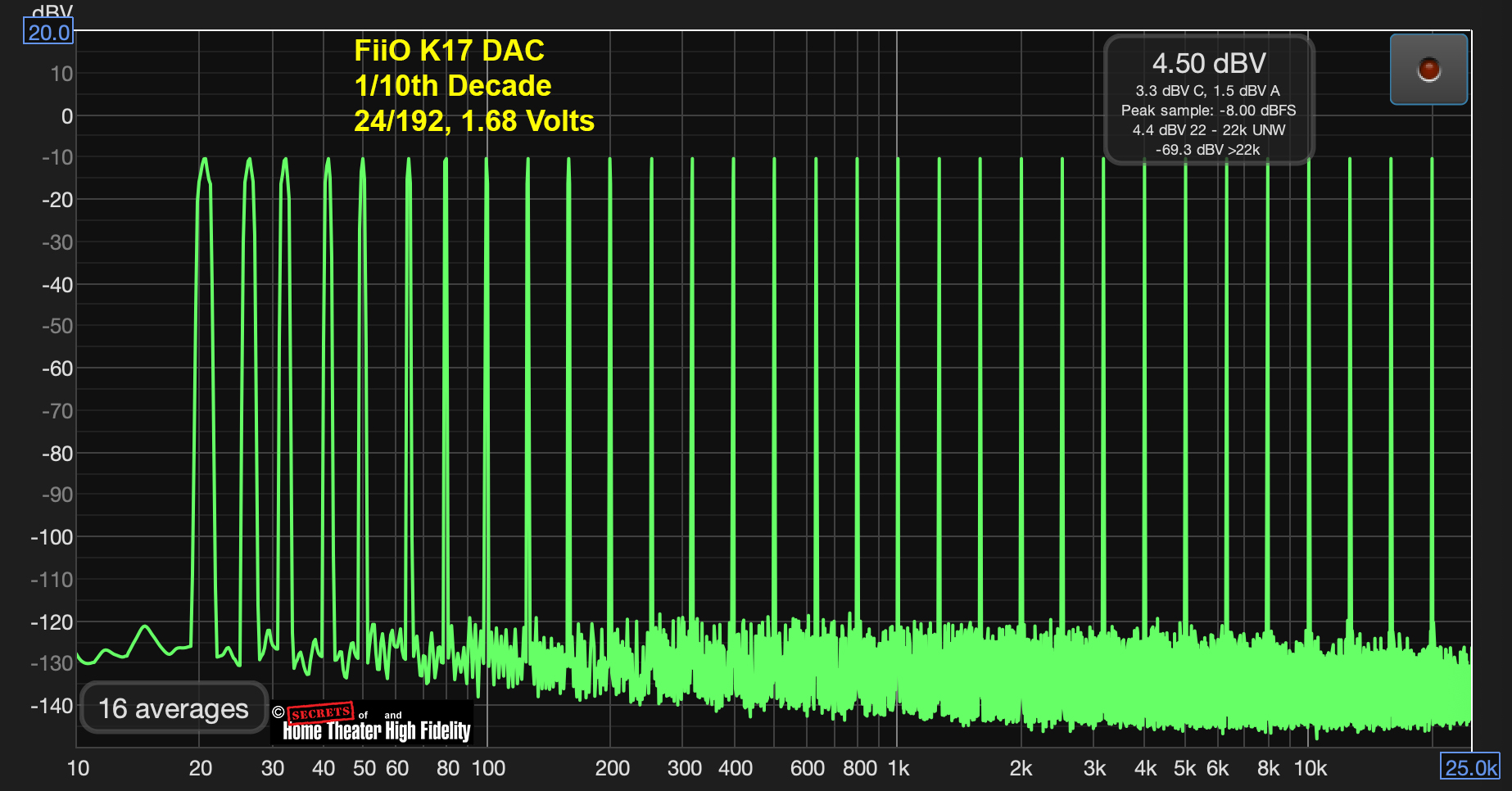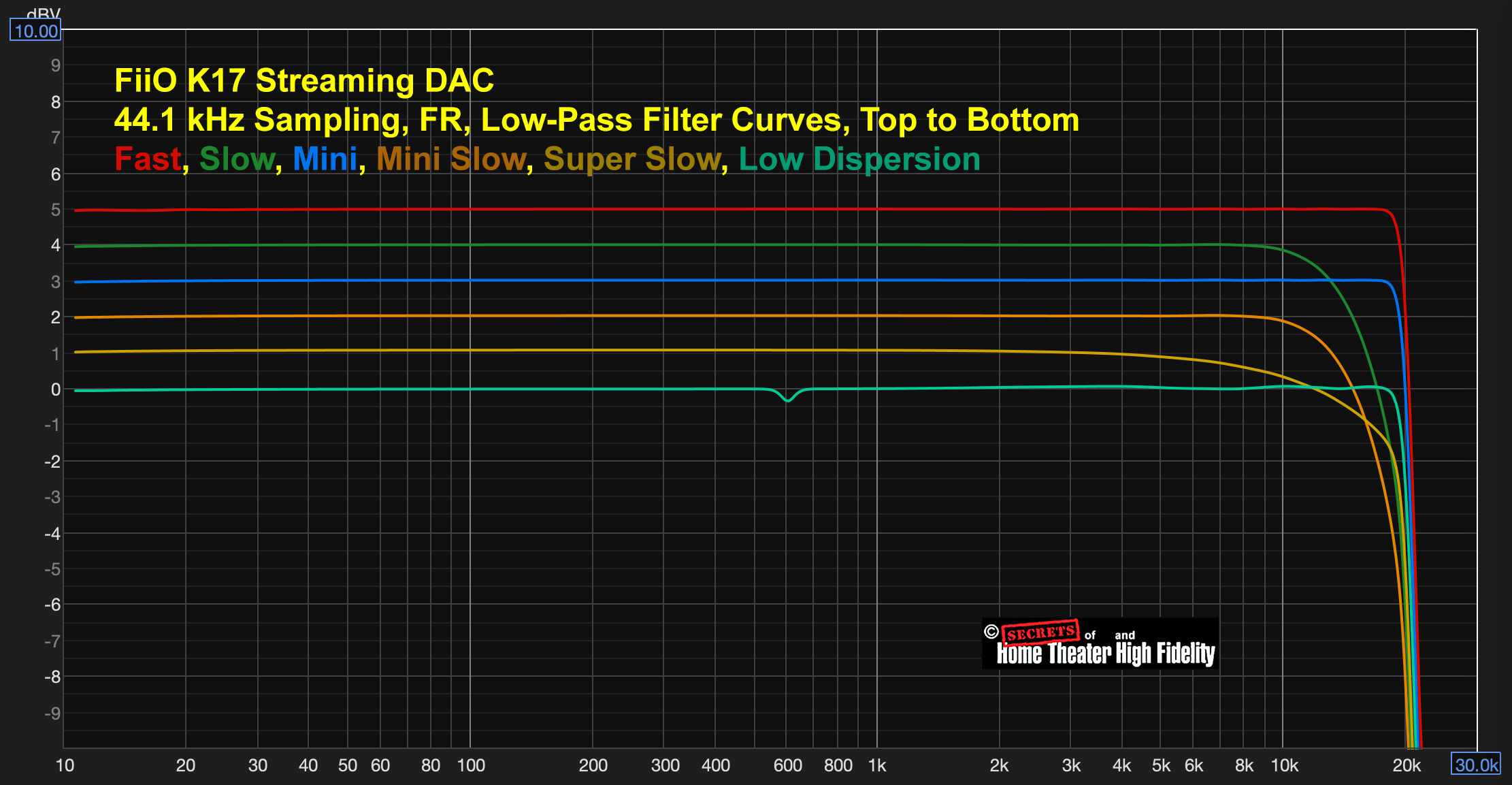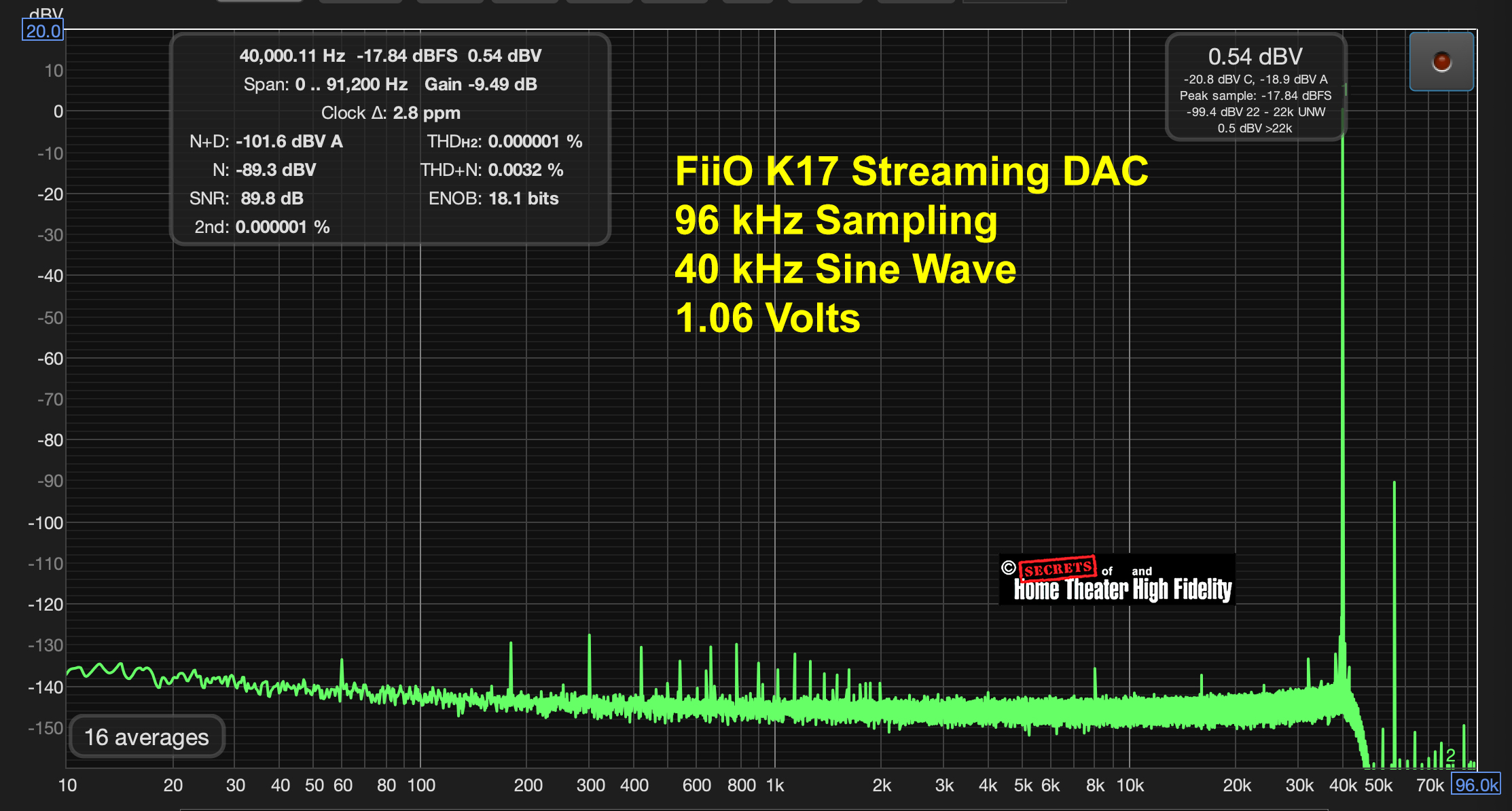Our phones have become our universal remote controls for them. Here is a very nice headphone amp/streaming DAC, the FiiO K17, which comes in just below $1,000.
FiiO K17 Desktop DAC and Headphone Amplifier
- Low distortion
- Lots of features
- Digital outputs for connection to other DACs
In the pursuit of exceptional audio quality, every component in a hi-fi system plays a critical role – and high up on that list of importance is the digital-to-analog converter (DAC). A DAC serves as the crucial bridge between the digital music files stored on our devices and the analog signals that ultimately drive our speakers or headphones. No matter how high-resolution the source file or how powerful the amplifier and speakers, the sound can only be as good as the weakest link in the chain. That’s why investing in a high-quality DAC is not just a luxury but a necessity for anyone serious about accurate, immersive sound reproduction. As streaming becomes the dominant way we consume music, the importance of a reliable, transparent, and musical DAC at the front end of your system has never been greater.
The FiiO K17 Desktop DAC and Headphone Amplifier enters this landscape promising to be more than just another digital converter. Combining advanced Delta-Sigma digital processing, high-end components, and a sleek, modern design, the K17 aims to deliver a listening experience that brings you closer to the original performance.
With features designed to support ultra-high-resolution files (32/384 PCM and DSD512) and a robust analog output stage, it seeks to eliminate bottlenecks in your audio chain and reveal details that lesser DACs might smear or obscure.
For audiophiles and discerning listeners alike, the FiiO K17 represents a compelling proposition – an affordable yet refined gateway to rediscovering your favorite music with newfound depth, clarity, and emotional impact.
MSRP:
$989.99 USD
Website:
Company:
SECRETS Tags:
FiiO, K17, Desktop DAC, Headphone Amplifier
Secrets Sponsor
The FiiO Desktop DAC and Headphone Amplifier uses AKM AK4191 + AK4499EX Delta-Sigma chips. AKM calls this combination a DAC Solution.
Here is a detailed technical summary of the AKM AK4191 + AK4499EX DAC solution, which is a flagship-level combination from Asahi Kasei Microdevices (AKM), widely used in high-end DACs and audiophile products.
Overview
● AK4191: A separate digital delta-sigma modulator chip that converts PCM digital audio into a sigma-delta modulated bitstream.
● AK4499EX: The analog DAC chip that performs the actual digital-to-analog conversion. It converts native DSD audio into the analog signal, and it accepts the delta-sigma bitstream from the AK4191 chip that has converted PCM digital audio into delta-sigma format.
This design approach splits the digital processing and the analog conversion to minimize noise and interference, improving ultimate sound quality.
Sound Quality & Performance
Noise floor & Dynamic range
● The combination achieves an extremely high signal-to-noise ratio (SNR) and dynamic range.
● The AK4499EX itself offers around 135 dB SNR and -124 dB THD+N (Total Harmonic Distortion plus Noise), among the best in the world for audio DACs.
Channel Separation & Detail
● Splitting the modulator and analog circuit helps reduce jitter and clock noise, improving imaging and microdetail.
● Many reviewers and measurements indicate an exceptionally smooth, natural, and “analog-like” sound signature, which is why high-end brands (e.g., Luxman, Esoteric, some Astell&Kern players) have adopted this design.
Digital filters & Flexibility
Technical Features
● The delta-sigma modulator chip (AK4191) offloads digital noise shaping from the DAC chip.
● 4-channel mono DAC (AK4499EX) with current output design, allowing very high-quality I/V (current-to-voltage) conversion stages.
● Supports PCM up to 1,536 kHz / 64-bit and native DSD up to DSD1024 in some implementations.
● Excellent linearity at very low signal levels, important for detail retrieval.
Cost
● The AK4499EX is a flagship chip and commands a high price.
● The pair (AK4191 + AK4499EX) is typically used in products above $1,500, often in the $3,000–$10,000 range for finished DAC or integrated amplifier products.
● As raw chips, the AK4499EX can cost ~$100–$200 each, depending on quantity, and the AK4191 adds additional cost. Plus, manufacturers must invest in premium analog output stages and power supplies to fully realize the potential.
Strengths & Considerations
Pros:
● Exceptional dynamic range and distortion specs.
● “Natural and musical” tonality.
● Low noise, especially in complex or quiet passages.
Cons:
● Expensive to implement fully — requires careful analog design and costly supporting components.
● Overkill for non-reference systems or budget-oriented products.
Here’s a comparative chart of all the premiere Delta-Sigma DAC chips now in the marketplace, followed by some example commercial products using the AK4191 + AK4499EX combo.
Comparative Chart: Top Modern Delta-Sigma DAC Chips
| Feature | AKM AK4191 + AK4499EX | ESS ES9039PRO | Burr-Brown PCM1795 | Rohm BD34301EKV | Cirrus Logic CS43198 |
| Architecture | Delta-sigma, split modulator/DAC | Delta-sigma, integrated | Delta- sigma, integrated | Delta-sigma, separate analog stages | Delta- sigma, integrated |
| SNR (max) | ~135 dB | ~132 dB | ~129 dB | ~130 dB | ~130 dB |
| THD+N | ~–124 dB | ~–122 dB | ~–105 dB | ~–120 dB | ~–108 dB |
| MaxPCM | 1536 kHz / 64-bit | 768 kHz / 32-bit | 192 kHz / 24-bit | 768 kHz / 32-bit | 384 kHz / 32-bit |
| Max DSD | DSD1024 | DSD1024 | DSD128 | DSD512 | DSD256 |
| Output stage | Current output requires I/V stage | Voltage or current, flexible | Current output, requires I/V | Current output | Voltage output |
| Tonality | Natural, “analog-like” | Precise, analytical | Warm, musical | Balanced, smooth | Smooth, warm |
| Used in | Flagship hi-end DACs, discrete analog stages | Reference DACs, many high-end and pro audio products | Older and classic high-end DACs | Recent boutique high-end DACs | Portable & mid-tier audiophile gear |
And, here are current distributor prices (USD) for each DAC IC (single-unit unless noted):
| Chip | 1-pc price (USD) | Notes |
| AKM AK4191 + AK4499EX | $66.04 total (= $11.21 + $54.83) | 10-pc combined ≈ $53.93 (= $8.78 + $45.15). Mouser Electronics+1 |
| ESS ES9039PRO (ES9039SPRO) | $91.00 | 5-pc: $78.52; 25-pc: $72.80. Mouser Electronics |
| Burr-Brown / TI PCM1795 | $6.36 (PCM1795DBR cut-tape) | Tube version shows $7.20; 10-pc: $4.87. Mouser Electronics+1 |
| ROHM BD34301EKV | $125.71 (cut-tape) | 10-pc: $105.93; 25-pc: $100.99; 1,000-pc (tape/reel): $90.14. DigiKey |
| Cirrus Logic CS43198 | $18.43 (CS43198-CNZ) | 10-pc: $13.02; 25-pc: $11.61. |
“Tube version” in the above table does not refer to vacuum tubes. It is shorthand for “tape-and-reel packaging”, which is how semiconductor distributors often list parts:
- Cut-Tape – distributor literally cuts a strip of tape from a reel and sells a few chips (good for hobbyists or low-volume).
- Tube – chips are supplied in long plastic tubes (often for DIP or SOIC packages).
- Tape-and-Reel – full reels of parts for automated pick-and-place machines.
So, for the TI / Burr-Brown PCM1795 DAC:
- PCM1795DBR (cut-tape): ≈ $6.36 per chip.
- PCM1795DBR (tube packaging): ≈ $7.20 per chip.
- Quantity 10+ (cut-tape): price drops to ≈ $4.87 each.
Examples of Other DACs Using the AK4191 + AK4499EX Chip Combination
Esoteric N-05XD
● Flagship network DAC/preamplifier.
● Uses AK4191 + AK4499EX combo for very high-resolution, smooth presentation.
● ~$12,000 USD price range.
Astell&Kern A&ultima SP3000
● High-end DAP (digital audio player).
● Dual AK4191 + dual AK4499EX (fully balanced dual-mono architecture).
● ~$3,700 USD.
Luxman D-07X and D-10X SACD/DAC
● Luxman’s reference SACD players and DACs.
● High-end internal clocking and discrete analog output stages.
● ~$10,000–$15,000 USD.
Cayin CS-100DAC
● Desktop DAC/preamp.
● Dual AK4191 + dual AK4499EX implementation.
● ~$4,000 USD.
Accuphase DC-1000
● Flagship digital processor/DAC.
● Also implements advanced analog circuitry around the AKM solution.
● ~$20,000 USD.
The AK4191 + AK4499EX combination is typically chosen in products that:
● Focus on musicality, richness, and natural detail rather than hyper-analytic “measurement-chasing” alone.
● Include very advanced analog stages to fully utilize the current-output architecture.
● Target serious audiophiles and premium system integrators.
The AK4191 + AK4499EX combination is currently among the highest-performing DAC solutions available, comparable to top ESS chips (e.g., ES9039PRO) and rivaling discrete R2R ladder DACs in some subjective listening tests. It is particularly favored by brands prioritizing a natural, analog-like presentation rather than hyper-analytical sound. Note that the FiiO K17 is at a very low price compared to other DACs using the AK4191/AK4499EX chips.
The ESS ES9039PRO DAC Chip is also a very popular top-of-the-line DAC chip, and it is used in the FiiO K19 Streaming DAC.
ES9039PRO Architecture & Design
● Architecture: 8-channel HyperStream® IV DAC architecture (most commonly configured as 4 channels per stereo side for fully balanced output).
● DAC type: Delta-Sigma.
● Output: Can be configured as current-mode or voltage-mode (voltage mode simplifies design, but many high-end implementations still use discrete I/V stages for best performance).
Performance Specs
● SNR (Signal-to-Noise Ratio): Up to 132 dB.
● THD+N: As low as –122 dB (0.00008%).
● Dynamic range: ~132 dB.
● Max PCM resolution: Up to 768 kHz / 32-bit.
● Max DSD: Native DSD512 (direct DSD path).
● Jitter reduction: Proprietary jitter elimination circuit, called “Time Domain Jitter Eliminator.”
Key Features
● Advanced digital filters: Multiple selectable filter options for different sonic preferences (fast, slow, apodizing, etc.).
● Volume control: Fully digital volume control with 32-bit resolution (eliminates external analog volume if desired).
● THD compensation: ESS patented “THD compensation” circuit to reduce harmonic distortion even further.
● Low power modes: Designed for efficient performance in both portable and desktop applications.
Sound Signature
● Often described as extremely precise, analytical, and detailed, with exceptional channel separation and micro-resolution.
● Some find it more “clinical” or “neutral” compared to AKM’s more “organic” or “analog-like” presentation.
Examples of High-End DACs Using ES9039PRO
Matrix Audio Element X2 Pure
● Full-sized streaming DAC and preamp.
● Dual ES9039PRO chips in fully balanced dual mono.
● ~$4,500 USD.
Topping D90 III (newest generation)
● Compact desktop DAC.
● ESS ES9039PRO single-chip implementation.
● ~$900 USD.
SMSL VMV D2R
● High-end DAC in SMSL’s flagship VMV line.
● ESS ES9039PRO, advanced analog output stage.
● ~$1,500 USD.
Cayin Fantasy desktop DAC (prototype/demo)
HiFiMAN EF600 (newer versions)
● Headphone DAC/amp.
● Integrated ES9039PRO for ultra-low distortion, high power delivery.
| Feature | ESS ES9039PRO | AKM AK4191 + AK4499EX |
| SNR | ~132 dB | ~135 dB |
| THD+N | ~ –122 dB | ~ –124 dB |
| Tonality | Analytical, very precise | Natural, “analog-like” |
| Filters | Very flexible | Flexible but less aggressive filters |
| Implementation Cost | Slightly lower (simpler voltage mode possible) | Higher (requires high-end analog stages) |
The ESS ES9039PRO is designed for extreme measurements and ultimate transparency, making it popular with measurement-oriented brands (e.g., Topping, SMSL, Benchmark). It delivers top-level detail retrieval, extremely low distortion, and high flexibility, which appeals to those wanting maximum “accuracy” rather than a “musical” coloration.
Delta-Sigma Modulation is the technology behind DSD (Direct-Stream-Digital) encoding and decoding. PCM digital audio is converted to a Delta-Sigma bitstream before decoding in a Delta-Sigma DAC. However, what happens in a Delta-Sigma DAC is different than simply converting the PCM signal to a DSD signal.
- Oversampling/Interpolation: The incoming PCM signal (e.g., 44.1kHz/16-bit) is first oversampled to a much higher rate (often 128x, 256x or higher) using digital filters. This creates more samples but still in multi-bit PCM format.
- Delta-Sigma Modulation: The oversampled multi-bit signal then goes through a delta-sigma modulator, which converts it to a high-frequency 1-bit (or sometimes multi-bit) stream using noise shaping. This pushes quantization noise out of the audio band.
- Analog Conversion: This high-frequency bitstream drives a simple 1-bit DAC (essentially a switch), followed by analog filtering to remove the high-frequency noise.
The crucial distinction: while this internal bitstream is conceptually similar to DSD (both use delta-sigma modulation), it’s not the same as converting to the DSD format. The modulator parameters, sampling rates, and noise shaping characteristics are optimized for the specific DAC design, not to comply with DSD specifications (like DSD64’s 2.8224MHz or DSD128’s 5.6448MHz).
Some modern DACs can accept both PCM and DSD inputs, but when processing PCM, they’re using their own internal delta-sigma modulation scheme, not converting to DSD as an intermediate format.
The other type of DAC is called an R-2R or Ladder DAC.
This type of DAC uses a series of very precise resistors (either 10 Ohm or 20 Ohm) to convert the digital music file to analog audio, and it uses the PCM principle rather than Delta-Sigma. In an R-2R DAC, there is a separate DSP chip that converts a DSD audio bitstream to PCM before the bitstream enters the DAC chip itself. The resistors consist of only two values: 10 Ohms and 20 Ohms. That is why it is called an R (10 Ohms) – 2R (20 Ohms).
The ladder DAC uses a series of digital bits, each controlling a switch that connects either a fixed voltage (e.g., 1.8 V, 3 V, or 5 V) or ground to a precisely arranged network of resistors. This R-2R ladder acts as a passive voltage divider, summing the weighted contributions of each bit. Each switch contributes 1/2 the voltage of the previous switch, and only the 1s (ones) in the digital sample open the switch. When a bit is 0, its switch does not open. So, the total voltage delivered to the output for a specific sample is unique to that string of 1s and 0s.
The most significant bits (MSB) contribute more to the output than the least significant ones (LSB or Least Significant Bits), due to the resistor network’s binary weighting. The result is a stepped analog voltage that approximates the original waveform, which is then smoothed by a low-pass filter to reconstruct a clean analog signal.
Ladder DACs generally have a 20-bit limit in resolution, and there are good reasons you don’t see real 24-bit ladder DAC chips.
Why 20 bits is the practical ceiling for ladder DACs
Resistor matching limits:
To be monotonic to N bits, resistor ratios in the ladder must be matched to roughly 1 / 2ⁿ. (Monotonic” means the DAC output always moves in the correct direction (up when the code increases, down when the code decreases) and never reverses for any 1-LSB step. If the resistors in a ladder DAC are not precise enough, a particular code change could produce an output that is slightly lower than the previous code — breaking monotonicity.)
For 20 bits: ~1 ppm (parts per million) matching (already at the edge of thin-film laser-trim capabilities).
For 24 bits: ~60 ppb (parts per billion) matching — far beyond current volume semiconductor processes.
Temperature drift:
Even if you trim at room temperature, keeping 24-bit linearity over temperature would require sub-ppm/°C tracking. That’s not realistic in standard IC processes without extreme cost.
Glitch energy:
At very high resolutions, tiny switching glitches and parasitic capacitances swamp the smallest code steps.
Noise floor:
Thermal noise in resistors and output stages is well above the voltage of a 24-bit LSB in most real circuits.
What’s actually on the market
Monolithic precision ladder DACs (like TI DAC11001A or Analog Devices AD5791) top out at 20 bits. Some older parts are 18 bits (AD5781, DAC8802, etc.).
Definition of “Monolithic”
The entire resistor ladder and switching network is fabricated on a single semiconductor die.
All resistors are made from the same thin-film or polysilicon material so that ratios (R and 2R) match closely.
This is opposed to discrete ladder DACs, where each resistor is a separate physical part on a PCB (as in Holo Audio or Denafrips).
Why there’s no true 24-bit ladder DAC for audio
A 24-bit LSB at 4 V full-scale is only ~238 nV — well below thermal noise for typical resistor sizes at room temperature.
Even in lab-grade systems, thermal noise and reference noise swamp that level, so those extra bits would be meaningless in analog form.
R-2R Ladder DACs vs. Delta-Sigma DACs
R-2R Ladder DACs
Pros
● Very linear theoretical performance: Properly designed R-2R DACs can achieve excellent linearity (accurate amplitude representation), especially if resistor matching is extremely precise.
● Natural “analog-like” sound signature: Many audiophiles describe them as smoother or more “musical,” partly because they often have simpler architectures without heavy digital filtering or noise shaping.
● Low digital processing noise: No aggressive noise shaping (as in Delta-Sigma), so high-frequency noise artifacts are often lower.
● Consistent output impedance and behavior: Because they don’t rely on high-frequency switching, they can have more stable analog output stages.
Cons
● Difficult and expensive to manufacture: Requires extremely precise resistors (often with 0.01% or better tolerance) to maintain good linearity at higher resolutions (e.g., 20–24 bits).
● Limited to lower sampling rates or resolutions in practice: Beyond 20 bits, resistor accuracy becomes impractical.
● Thermal drift: Resistor values can change slightly with temperature, affecting performance.
● Generally higher cost: High-end R-2R DACs (e.g., MSB, Holo Audio) are expensive due to precision components and calibration
Delta-Sigma DACs
Pros
● Easier to mass-produce: Use digital oversampling and noise shaping to achieve high resolution with less demanding analog components.
● Very high theoretical dynamic range and low noise: Noise shaping pushes quantization noise out of the audible band, enabling up to 120 dB or more dynamic range.
● Cost-effective: Because of modern semiconductor manufacturing, even budget DAC chips can achieve excellent objective measurements.
● High sample rate support: Easily support formats like DSD and high-rate PCM (e.g., 384 kHz, 768 kHz).
● Compact integration: Often includes integrated filters, I/V conversion stages, and even headphone amps, reducing overall system size and complexity.
Cons
● Heavier digital filtering and noise shaping: Can introduce high-frequency noise, which must be filtered carefully.
● Perceived “clinical” sound: Some listeners describe them as more analytical or “sterile,” though this is subjective.
● Potential for ultrasonic noise: Improper or insufficient output filtering can let noise above 20 kHz pass to amplifiers and speakers
| Feature | R-2R Ladder DAC | Delta-Sigma DAC |
| Linearity | Excellent if built well | Very good, achieved via digital techniques |
| Cost | High | Lower |
| Manufacturing | Complex | Mass-produced easily |
| Sound Character | Often described as smooth, natural | Often described as clean, precise |
| High-res Support | Difficult beyond 20 bits | Up to 32 bits, high sample rates easily, but usually do not resolve more than about 22 bits. |
Noise Shaping None Heavy
Ultrasonic Noise Low Potentially High
The choice?
● If you value pure measurements and cost-efficiency, or want compact all-in-one designs → Delta-Sigma.
● If you prefer a distinctive, “analog-like” character and are okay with higher cost, or want a more minimalist digital approach → R-2R Ladder DAC.
An R-2R DAC can play a 24-bit, 192 kHz PCM file — but with some important technical and practical caveats.
Resolution (Bit depth)
● A 24-bit PCM file contains 24 bits of amplitude resolution.
● In practice, no DAC (even Delta-Sigma) achieves true 24-bit linearity — most achieve around 20–21 “effective” bits due to noise and imperfections.
● R-2R DACs theoretically can accept 24-bit input, but accurate resistor matching to realize true 24-bit resolution is nearly impossible.
In practice:
Sampling rate (192 kHz)
● The sampling rate (e.g., 192 kHz) determines how often amplitude samples are sent.
● R-2R DACs do not have an inherent limitation in clocking high sample rates, as long as the input receiver and logic are designed to support it.
In practice:
● Modern R-2R DACs usually support up to 192 kHz, 384 kHz, and even higher rates for PCM.
● Some also support NOS (Non-Oversampling) playback at these rates, appealing to certain audiophiles.
Oversampling and filtering
● Many R-2R DACs run in NOS mode, meaning they skip oversampling and digital filters, playing samples directly at the native rate.
● Others offer optional oversampling modes, which require extra logic but still use R-2R conversion for the final step.
The first digital-to-analog converters were developed in the 1940s and 1950s, with early examples using weighted resistor networks.
R-2R ladder DACs were one of the earliest practical architectures, developed in the 1950s and 1960s. They became popular because they only required two resistor values (R and 2R) rather than the precisely weighted resistors needed in earlier designs, making them easier to manufacture accurately.
By the 1980s, several DAC architectures were in common use:
- R-2R ladder DACs – Still popular for their simplicity and good performance
- Weighted current source DACs – Common in integrated circuits
- String DACs (Kelvin divider) – Used for guaranteed monotonicity
- Hybrid architectures – Combining different techniques
The 1980s also saw the early development of oversampling and sigma-delta DACs, though these didn’t become mainstream until the late 1980s and 1990s, particularly in CD players.
So while R-2R ladder DACs were certainly prevalent in the 1980s and were among the first practical DAC designs historically, they weren’t the only architecture in use by that decade. The 1980s represented a mature period for DAC technology with multiple competing approaches, each with different trade-offs for cost, accuracy, and speed.
The gap between DAC invention and music industry adoption had several major barriers:
Storage Was the Killer Problem
Digital audio requires enormous amounts of data. CD-quality audio (44.1 kHz, 16-bit stereo) needs about 10 MB per minute. In the 1960s, that much storage cost hundreds of thousands of dollars. A single album would require multiple refrigerator-sized disk drives or rooms full of magnetic tape machines.
Complete Digital Chain Needed
DACs alone weren’t enough – you needed:
- High-quality ADCs (analog-to-digital converters) for recording
- Digital storage systems
- Digital processing capability
- Error correction systems
- Standardized formats
Each component had to reach sufficient quality and affordability.
Early Digital Audio Timeline
- 1960s: Bell Labs experiments with computer music, but systems filled entire rooms
- 1967: First digital audio tape recorder by NHK in Japan – it weighed several tons
- 1972: Denon’s first commercial digital recorder – cost over $100,000
- 1977: Sony PCM-1 processor – still very expensive but more practical
- 1979: Sony PCM-1600/1610 – the breakthrough that studios could actually afford
- 1982: Compact Disc launch – made digital playback consumer-viable
Why the 1980s?
The convergence happened because:
- Semiconductor prices had fallen dramatically
- 16-bit ADCs/DACs finally achieved good enough quality
- Digital tape technology (especially video-based PCM adapters) provided practical storage
- The CD standard created market demand
So while DACs existed early on for radar, telecommunications, and computing applications, they weren’t good enough, cheap enough, or part of a complete enough system for music until roughly 40 years after their invention.
The engineering of PCM recording and playback is discussed in this technical article.
Secrets Sponsor
The front panel has a large LED status panel. This shows the input and type of digital audio file that is being processed. The menu and volume control dials are on the right-hand side with multiple style headphone jacks underneath. Power On/Off is on the left side (also a toggle on the rear panel if you don’t want to have the K17 in standby power all the time), then a selector knob for activating the headphone power amp circuit, the preamplifier circuit (if you want to have power out to a main preamplifier or even directly to a power amplifier), and what’s labeled as “LO”, which is preamplifier line output bypassing the volume control.
The labels of the first knob are as follows:
PO+PRE: Simultaneous headphone and line output, with volume and gain adjustments affecting both.
PO: Only headphone outputs are active (6.35mm, 4.4mm, XLR 4 pin).
PRE: Only line outputs are active (RCA, XLR 3 pin), with adjustable volume (unaffected by gain).
LO: Fixed maximum volume line output (volume and gain controls disabled). Make sure subsequent devices in the signal path are set to appropriate levels to avoid loud noises.
The next knob adjusts the gain, which allows you to have a varying range in the volume control section, meaning that you can adjust the range of volume being sent to your main preamplifier. There is also a USB-C input port for connecting your laptop to stream music stored there or through a streaming service like Qobuz, which is what I used. There are three headphone ports: one 1⁄4” single-ended phone jack, one 4.4 mm balanced Pentacon style, and one 4-pin XLR balanced.
The K17 can output voltage to drive just about any set of headphones out there, so turn the volume control down all the way to start out, then start to play the music and adjust the volume accordingly. The volume is also affected by the selections on dial number three from the left on the bottom. Select the lowest setting to start with. Be careful! This thing kicks butt.
You can select from several menus by sliding your finger across the LED screen from left to right or right to left. Here are the two main menus. You will have to get up close to the K17 to read them because there are so many items.
You can connect to your network either wired (LAN) or wirelessly (WLAN) for streaming. I used WLAN, and the signal was very good. I selected Streaming from the menu shown above for this. You can also play music files from a USB thumb drive or large SSD/HD as well. Select Local Play (in menu shown above) for this and use the phone app to choose the music. This is an excellent way to play your music library through the K17, feeding the output to your main preamplifier, which in my case, is a Pass Labs Xs (see In Use section). You can do it from across the room or next room (such as your dining room, with your hi-fi system in the living room) if you want to choose and play music during a meal.
You can choose from six digital low-pass filters: Fast, Slow, Mini (Minimum Phase), Mini Slow, Super Slow, and Low Dispersion. The Fast filter is the default.
The rear panel is shown below. Click on the photo and zoom in to see the labels on the various ports.
There is a myriad array of inputs here, including optical, coaxial, USB-C (instead of USB-B), and Ethernet. There are also optical and coaxial digital outputs if you want to pass through the digital signal to an additional DAC such as in your home theater processor. RCA analog inputs and outputs as well as XLR analog outputs round out the K17. If you use the RCA analog inputs, the signal is routed to the XLR analog outputs for the K17 to serve as a stereo preamplifier. You can select PRE on the front of the K17 which means Preamplifier Output. The PO selection enables the headphone output.
The remote is small and contains buttons for basic functions.
I used a MacBook Pro M4 Max as my music source, via the Qobuz streaming service, connected to the FiiO K17 via USB-C on the laptop to the rear USB-C input on the K17. I also used the coaxial (RCA) input and the USB-A input on the K17. Output from the K17 was to a pair of OPPO PM-1 headphones. For use with amplifiers and speakers, I paired the K17’s XLR analog preamp outputs with a Pass Labs Xs Preamplifier, two Parasound JC 1+ Monoblock Power Amplifiers, MartinLogan CLX Full-Range Electrostatic Speakers, and two Paradigm Reference Signature SUB 2 Subwoofers. Cables were by Clarus Cable.

Ludwig van Beethoven, Consortium Classicum, “Beethoven: Chamber Music for Winds Vol.2
Beethoven (1779 – 1827) was a prolific composer of the Classical Period. This album contains chamber music for woodwinds, e.g., clarinet, oboe, etc. Woodwinds possess a rich, mellow tonality shaped by the natural resonances of air columns and the organic materials of the instruments. Their sound contains subtle, low-order harmonics that give them warmth and expressiveness. A hi-fi system must reproduce these nuances with care, avoiding artificial emphasis on higher-level odd harmonics, which can introduce harshness and glare. Poorly designed amplification, digital filtering, or distortion can exaggerate these upper harmonics, distorting the woodwinds’ smooth texture. Accurate reproduction demands low distortion, linear frequency response, and refined transient handling to preserve the delicate harmonic balance that defines the realism and emotional character of woodwind instruments. The FiiO K17 handled these with minimum harmonic edginess.

Diana Krall, “The Look of Love”
Diana Krall’s album, The Look of Love, puts her in the realm of romantic pop singer and does it well. She is an artist who transcends genres, blending jazz, blues, and traditional pop with effortless sophistication. While widely celebrated as a jazz pianist and vocalist, she also embodies the spirit of a romantic pop artist. The K17 shows her smoky, raspy voice carrying an intimate allure – perfect for a late evening in a dimly lit bar, where the mood is reflective and the music slow. Krall’s interpretations of classic love songs evoke a timeless sensuality, capturing both vulnerability and strength. Whether delivering a sultry ballad or a jazz standard, her artistry connects deeply with listeners, making her a true crossover icon in contemporary music. The K17 shows that.
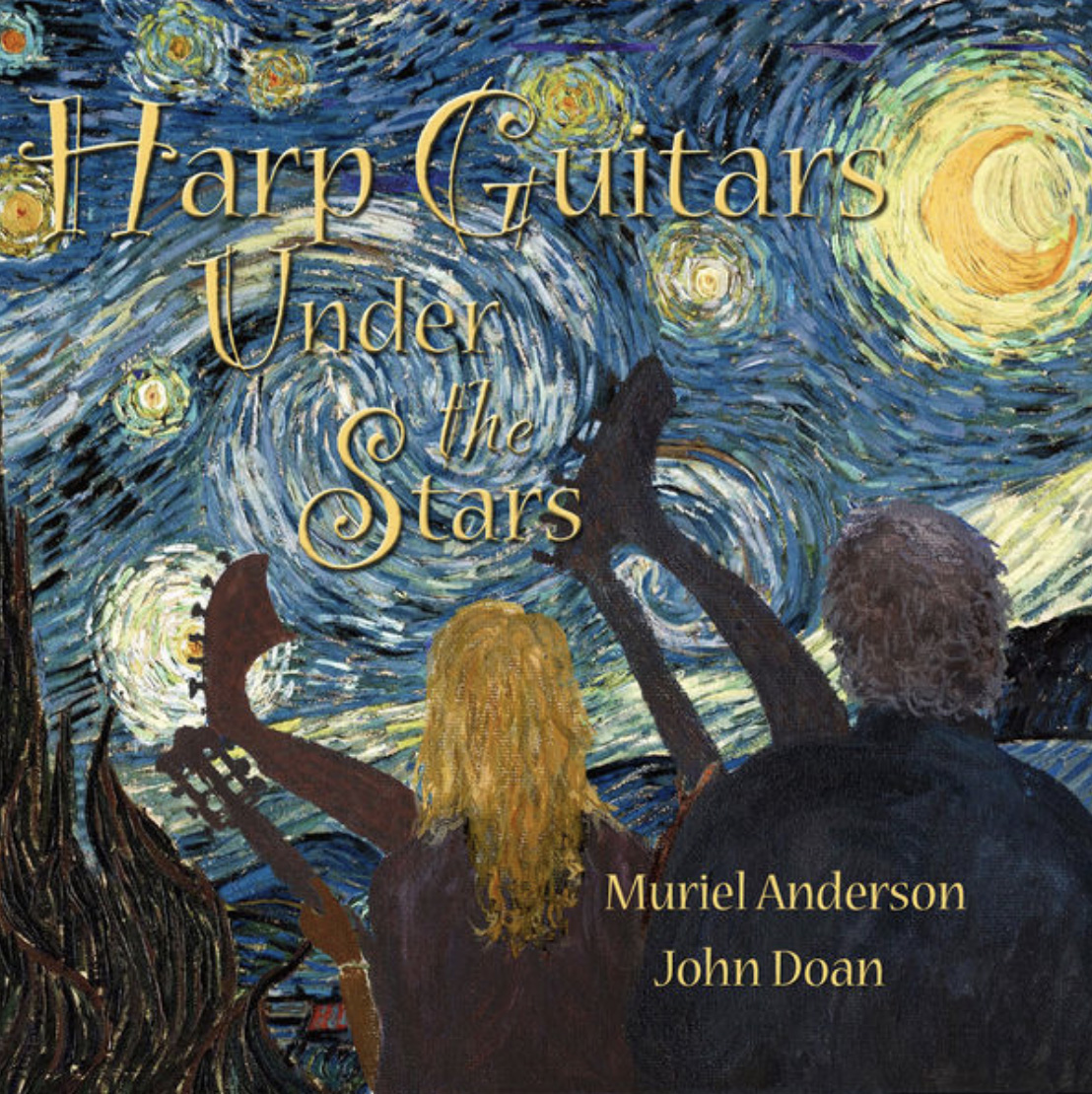
Muriel Anderson, John Doan, “Harp Guitars Under the Stars”
A harp guitar is an instrument that has both a guitar neck and harp, all on the same body. This album has a pair of them. The harp-guitar produces a uniquely enchanting sound – a fusion of delicate sweetness and tactile immediacy. Its sympathetic and sub- bass strings create a lush, resonant bed of harmonics, while the main strings deliver melody with clarity and nuance. Each note begins with the transient snap of the pluck, giving the instrument a vivid sense of presence and articulation. Yet as the sound blooms, the tone becomes round, warm, and almost ethereal. The interplay between the crisp attack and lingering overtones creates a layered sonic experience – both intimate and expansive – capturing the harp-guitar’s rare ability to be percussive and lyrical in a single gesture. The leading edge of the pluck is not easy to reproduce, but the K17 was up to the task.

John Zorn, Brian Marsella, Jorge Roeder, Ches Smith, “Impromptus”
Piano is a difficult instrument to reproduce in an audio system because so many notes can be played at the same time. Unlike many instruments, it can produce ten or more notes simultaneously, spanning the entire audible frequency spectrum – from deep, resonant bass to sparkling highs. Each note carries a distinctive transient, or leading-edge attack, which gives the piano its characteristic percussive clarity. These rapid bursts of energy must be captured and rendered with precision, or the realism and impact are lost. Reproducing a piano demands an audio system with exceptional dynamic range, low distortion, and phase accuracy. Otherwise, the complex harmonic interactions and overtones that define the instrument’s richness and realism become smeared, congested, or unnaturally harsh. The FiiO K17 does its job very well in this example album, Impromptus, released in July, 2025.
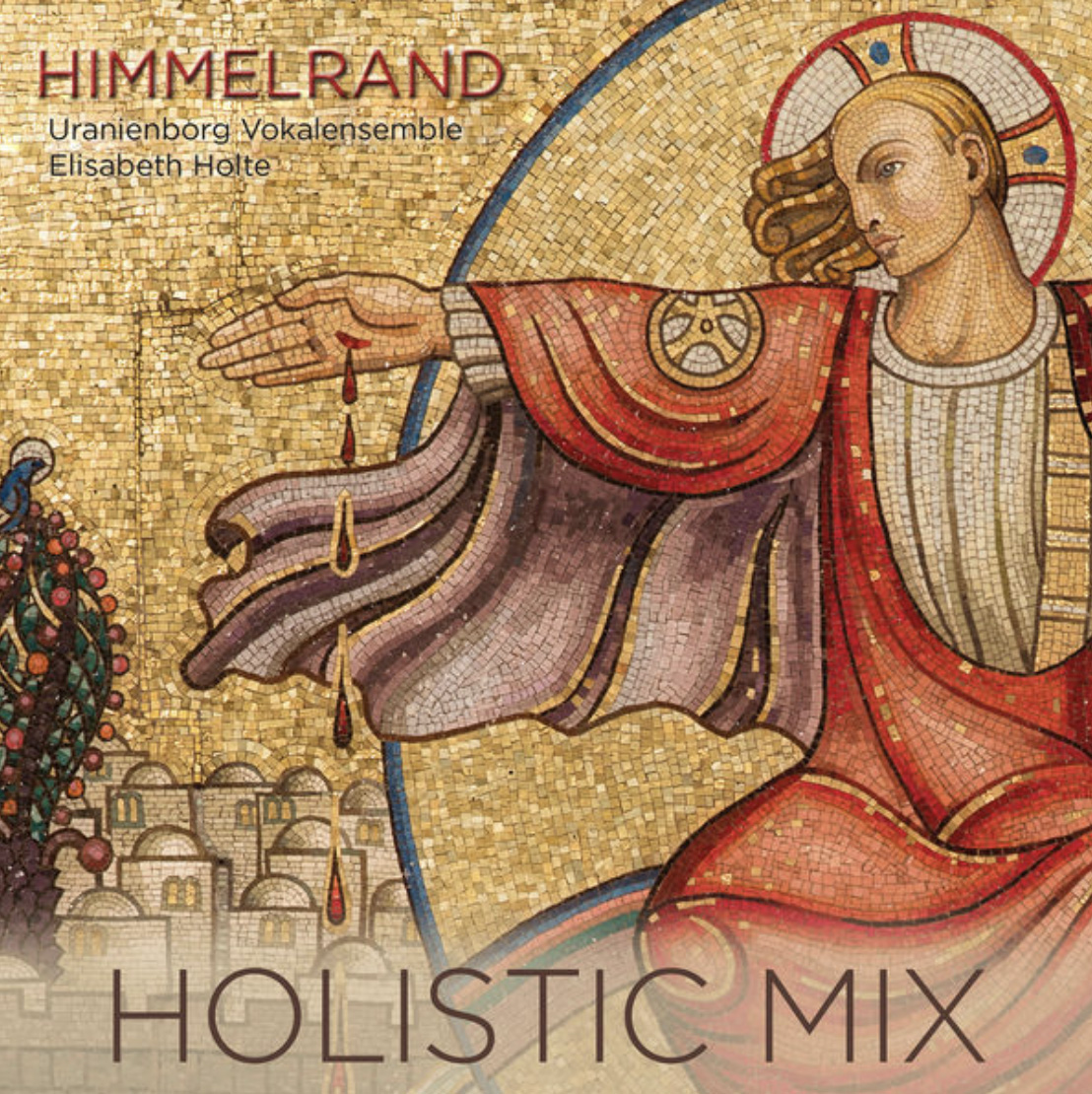
Uranienborg Vokalensemble, Elisabeth Holte, “HIMMELRAND: Holistic Mix”
Himmelrand is one of my go-to albums not just for testing DACs, but for listening to and showing off my audio system to visitors because of the deep, deep bass from the organ pedal tones (I have a total of twelve 12” drivers in two massive Paradigm SUB2 subwoofers, with a total of 10,000 watts via 240 Volt wall supplies). The pipe organ can generate fundamental frequencies well below 30 Hz, with some pipes reaching into the infrasonic range, creating a visceral impact that is felt as much as heard. To faithfully reproduce this, an audio system must not only reach these low frequencies but do so with authority, clarity, and minimal distortion. Unfortunately, many audio components – including speakers, amplifiers, and even DACs – can exhibit low-end roll-off, causing these critical frequencies to weaken or disappear altogether. When this happens, the full grandeur and scale of music with powerful low-end content are lost. The result is a reproduction that feels shallow and incomplete. A properly designed system with extended, flat bass response delivers the weight, space, and realism needed to capture the full emotion and majesty of instruments like the pipe organ. The K17 is flat down to 10 Hz, so the sound in this album was rattling my windows. It didn’t do as well with the headphones, but that is not unusual. Open-air headphones just cannot deal out 20 Hz with much authority.

Anne Akiko Myers, “Mirror in Mirror”
This is another go-to album for me (Mirror-in-Mirror) because Anne Akiko Meyers plays the highest notes achievable on her violin, and they are intense. Reproducing the sound of a violin with true high fidelity is one of the most demanding challenges in audio. The violin’s tone is shaped by complex harmonic overtones, subtle vibrato, and a rich interplay between the bow and string, all of which must be captured with accuracy and finesse. The upper harmonics extend well into the high-frequency range, and even the slightest distortion – particularly harsh, odd-ordered harmonics introduced by amplifiers, DACs, or speakers – can make the violin sound shrill or aggressive. This is especially problematic when reproducing the instrument’s higher notes, where the natural sweetness and fluidity can quickly be lost to metallic harshness or digital glare.
Moreover, violins don’t just produce single sine-like tones; they generate an evolving spectrum of frequencies that interact dynamically with the surrounding acoustic space. Preserving these subtleties requires a system with exceptional resolution, phase coherence, and low distortion across the entire audio band. Many systems either smear the detail or introduce unnatural edges to the sound. Achieving believable violin reproduction demands not only excellent components but also careful system matching, room acoustics, and source material quality. When done properly, the result is breathtaking realism; when not, the violin becomes a harsh caricature of its true self.
Meyers plays a 1741 Vieuxtemps Guarneri del Gesù violin, not a Stradivarius. While both Stradivarius and Guarneri are legendary violin makers from Cremona, Italy, the Vieuxtemps Guarneri is particularly renowned for its power, depth, and pristine condition.
This specific instrument is considered one of the finest violins ever made and was loaned to her for life by an anonymous donor. It’s worth many millions of dollars and is notable for its unmatched tonal beauty and projection, making it ideal for both solo performance and recording.
The FiiO K17 was up to the task with just the right amount of edge to match the violin’s natural tonality.
Here is a 1 kHz sine wave at 768 kHz sampling, validating the K17 specification that it will decode 768 kHz PCM. You can see that the 3rd-ordered harmonic is the predominant one, with the 2nd-ordered harmonic about 2/3rd as high as the 3rd. Noise shaping is present above 30 kHz.
I measured distortion with a 45 kHz low-pass to eliminate as much of the noise shaping effects as possible, and that is why THD+N is about an order of magnitude higher than just THD, which is extremely low (0.00029%). USB input. All Sigma-Delta DACs use noise shaping. The Effective Number of Bits (ENOB) here was 19.1 bits, even with the slight increase in noise between 20 kHz and 45 kHz from noise shaping. That’s very good.
With the noise shaping contribution between 20 kHz and 45 kHz removed for the measurement, the ENOB would have been about 20 bits, which for -6 dBFS input level, indicates lab-grade performance.
The figure below confirms that the K17 can decode DSD files, in this case, DSD64. The noise hump at 25 kHz is from the DSD64 test file. The noise hump above 40 kHz is from the K17 itself, which uses sigma-delta modulation (see the Design section of this review).
The IM test using 60 Hz and 7 kHz sine waves at 192 kHz sampling also resulted in low distortion (0.0013%). Coaxial input.
The use of 19 kHz and 20 Hz sine waves is also an IM test. Here, the main side peaks (d3L and d3H) are below -100 dBV. IMD was 0.00045%. The rest of the side peaks and the noise peaks are below -120 dBV. When I raised the output to 2.66 Volts, IMD was 0.0015%, and the 1 kHz B-A difference peak was at -102 dBV (data not shown). Coaxial input.
Distortion vs. Frequency at 192 kHz sampling is shown in the figure below. It is primarily 3rd-ordered (green line) up to about 10 kHz and then 4th-ordered (blue line). The 4th-ordered harmonics are generally below the noise floor (white line). The 2nd-ordered harmonics are shown in the red line. Coaxial input.
The 1/10th Decade test, shown below, illustrates that distortion concentrates in the midrange. The majority of distortion is below -120 dBV at a low/medium output voltage.
In the figure below, the Frequency Response is shown for 44.1 kHz, 96 kHz, 192 kHz, and 384 kHz sampling. 
Here is a table of the -3 dB Cutoff points for each of the four sampling frequencies:
| Sampling Rate | Line Color | -3 dB Cutoff Approx. | Roll-Off Type |
| 44.1 kHz | Blue | ~22 kHz | Steep, sharp roll-off just past Nyquist |
| 96 kHz | Green | ~48 kHz | Moderate slope |
| 192 kHz | Red | ~76 kHz | Softer roll-off |
| 384 kHz | Orange | ~105–110 kHz | Very slow roll-off |
The -3 dB point (also called the cutoff frequency, corner frequency, or half-power point) is critical in filter design because it defines the frequency at which the output signal power is reduced to half of the input power — and it marks the beginning of meaningful attenuation. A –3 dB drop = 0.707 x voltage amplitude, or 50% of power.
Here (below) is the frequency response using 44.1 kHz sampling and all six available filters. Fast (the top curve) rolls off quickly. Slow (second from the top) starts rolling off at about 8 kHz, while Super Slow (fifth from the top) starts rolling off at 1 kHz. Most people seem to prefer Fast, but it is worthwhile to just switch between the filters while listening to some of your favorite music tracks.
The presence of an 80 kHz 2nd-ordered harmonic in the noise-shaping band above 48 kHz with 96 kHz sampling (see figure below), using a 40 kHz test sine wave, suggests a mild 2nd-order roll-off in the analog op-amp output stage. It is FiiO’s choice, which is probably because they want to minimize phase shift, and is performed through firmware adjustment. Note that this is just a stress test to determine the roll-off characteristics in the op-amp. A user would not experience a large 40 kHz signal in music. The harmonic at 80 kHz appears high because of the very low noise floor at -140 dBV, which results from noise-shaping. In fact, the 2nd-harmonic is at 0.000001%.
Amplifiers that produce dominant third harmonic distortion are often considered warm-sounding, but with some nuance.
● Third-ordered harmonic distortion (3H) occurs at 3 x the input frequency. For example, if a 1 kHz sine wave is input, the 3rd harmonic appears at 3 kHz. The primary (fundamental) signal is the sine wave itself, and it is considered the 1st-order so as not to cause confusion in the ordered numbers for the harmonics.
● Unlike higher odd-ordered harmonics (e.g., 5th, 7th), which can sound harsh or dissonant, the 3rd harmonic is more musically consonant with the fundamental tone.
● The 3rd harmonic is a perfect fifth above the fundamental, which is a musically pleasing interval.
Perception of Warmth:
● Warmth in audio is typically associated with a slightly euphonic coloration, a mild thickening of the midrange, and a smoothness in the highs.
● Amplifiers that have a moderate amount of low-order harmonics (mainly 2nd and 3rd) can impart this sense of warmth.
- 2nd harmonic = often called “lush” or “sweet”
- 3rd harmonic = adds body and solidity, often interpreted as “warm” or “rich”
Important caveats:
● Too much 3rd harmonic can sound muddy or congested.
● The balance between 2nd and 3rd harmonic content, and how fast higher-order harmonics roll off, also strongly influences perceived warmth.
● Some tube amps (especially push-pull designs) suppress 2nd harmonic and emphasize 3rd—these often sound warm but more neutral than single-ended tube amps, which tend to emphasize 2nd harmonic.
Summary:
Amplifiers with dominant 3rd harmonic distortion, especially in small amounts, are often perceived as warm and full-bodied, though less “romantic” than those emphasizing 2nd harmonic. The FiiO K17 DAC has primarily 3rd-ordered harmonics with smaller 2nd- ordered harmonic peaks, and insignificant 4th, 5th, 6th, etc. harmonics. This gives the sound a bit of an edge, which emphasizes fine detail and transient edges.
FiiO’s K17 Streaming DAC is a bargain in its price range. It has every feature you could possibly want, and then some. It is easy to set up and a pleasure to use.
- Excellent performance vs. price
- Low distortion and high output
- Tons of features
- Easy to set up and use
- All settings available from phone app


